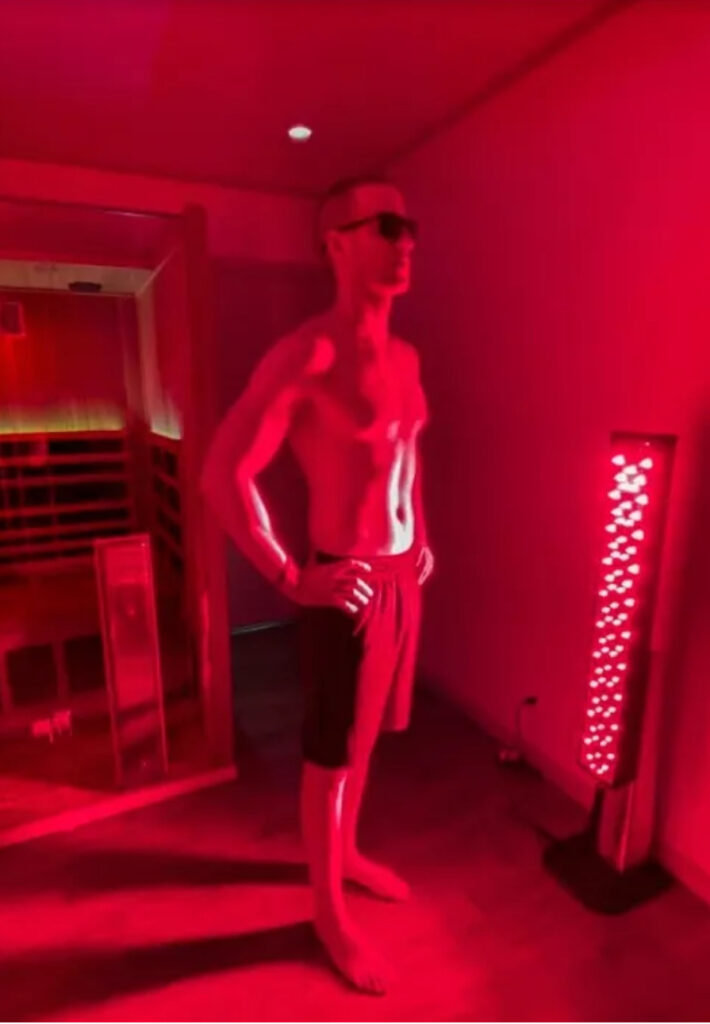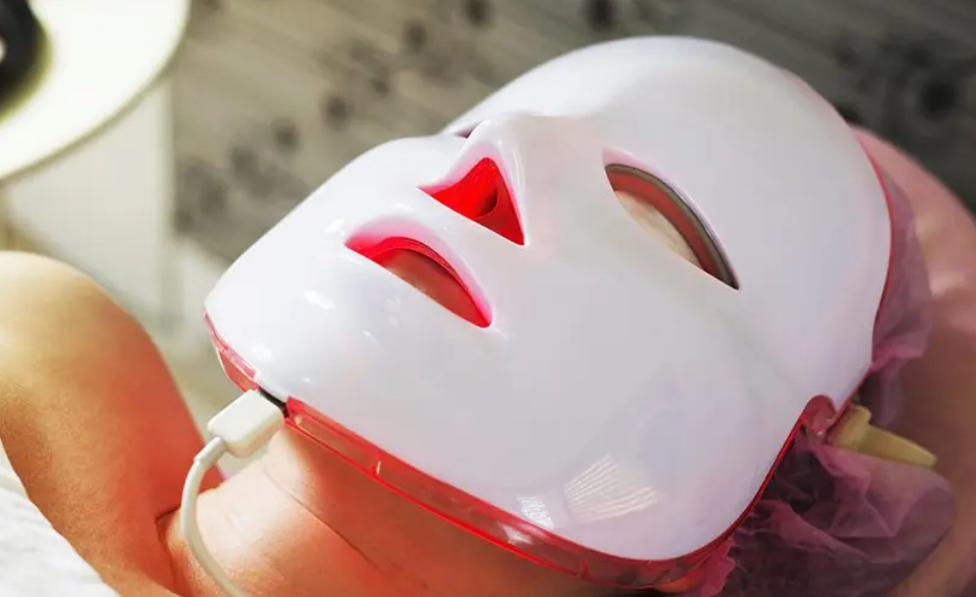If you’ve ever limped off the couch after leg day, tried to “walk it off” after tweaking your back, or considered bathing in an ice bucket just to feel normal again, you know the struggle of recovery. Enter red light therapy—the latest buzz in the physical therapy and wellness world that claims to help with soreness, speed up healing, and even boost performance.
But does standing in front of a fancy red glow really work, or is it just an expensive way to feel like a superhero? In this blog, we’ll break down the science behind red light therapy, its benefits for muscle recovery, potential drawbacks, and how to use it effectively.
What is Red Light Therapy?

How It Works on a Cellular Level
At its core, red light therapy is a form of low-level laser therapy (LLLT) or photobiomodulation (PBM) that uses specific wavelengths of red and near-infrared (NIR) light to penetrate the skin and stimulate cellular processes. The primary target? The mitochondria—the powerhouse of the cell.
When exposed to red and near-infrared light, mitochondria absorb photons, which boosts the production of adenosine triphosphate (ATP)—the energy currency of our cells. This increase in ATP helps cells repair and regenerate more efficiently, reducing oxidative stress and inflammation.
In other pronounceable words, imagine your body is like a city, and your cells are tiny factories working hard to keep everything running. Inside those factories, you have mitochondria, which are like the power plants—they produce the energy that keeps your body functioning.
Now, red light therapy is like giving those power plants a little boost. It uses specific types of red and near-infrared light that can go deep into your skin and reach your cells. When this light hits your mitochondria, it helps them work more efficiently, producing more energy (kind of like upgrading your power grid).
More energy means your body can repair itself faster, reduce inflammation, and recover from soreness or injuries more effectively. So, in simple terms—red light therapy is like plugging your body into a “cellular charger” to help it heal and function better. Does that make more sense?
Commonly Used Wavelengths & Their Effects
Not all red light therapy devices are created equal. The most effective wavelengths for muscle recovery typically fall within these ranges:
– Red Light (630-660nm) – Targets superficial tissues, aiding in skin healing, reducing inflammation, and promoting circulation.
– Near-Infrared Light (810-850nm) – Penetrates deeper into muscles, joints, and nerves, enhancing tissue repair and reducing pain.
The combination of these wavelengths makes red light therapy beneficial for muscle recovery, pain relief, and overall cellular function.
Research-Backed Benefits for Muscle Recovery

Studies on Performance, Inflammation, and Healing Speed
Research on red light therapy has been promising, particularly in the realm of muscle recovery and athletic performance.
– A 2016 systematic review published in Journal of biophotonics found that red light therapy may enhance muscle growth following training while also reducing inflammation and oxidative stress in muscle tissue.
– A 2022 study in Sports Health reported that athletes using red light therapy experienced faster recovery, reduced muscle fatigue, reduced muscle soreness, and enhanced muscle performance.
– Another study from the European journal of physical and rehabilitation medicine showed that red light therapy can help reduce pain in a variety of conditions, including non-specific knee pain, osteoarthritis, pain after total hip replacement, fibromyalgia, temporomandibular joint disorders, neck pain, and lower back pain. The therapy was deemed to be a safe, non-invasive, and drug-free option for pain relief, with no side effects. It appears to be effective for both acute and chronic musculoskeletal issues, as well as fibromyalgia.
What Our MHH Holistic Practitioners Are Saying
At Mitchell Holistic Health here in Onalaska, we know this is a trending topic but there is TONS of science on the benefits of red light therapy. People should have access to this great technology. There is a rumor that we might start offering this service in the near future, so stay tuned!
Potential Drawbacks & Misconceptions
Does It Work for Everyone?
While red light therapy shows strong potential, it’s not a one-size-fits-all solution. Some people experience dramatic improvements in pain relief and muscle recovery, while others may see minimal effects. Factors like skin type, injury severity, and individual mitochondrial function can influence results.
Additionally, overuse or improper application can lead to diminished benefits. More is not always better—red light therapy requires specific dosing and exposure times to be effective.
The Difference Between High-Quality & Ineffective Devices
Not all red light therapy devices on the market are not backed by science. Some consumer-grade models lack the correct wavelengths or don’t deliver enough power (irradiance) to penetrate deeply enough for muscle recovery.
– Quality Devices: Use 630-660nm (red) and 810-850nm (NIR) light at sufficient power levels (~100mW/cm²).
– Ineffective Devices: Often use LEDs without proper power output, leading to little or no therapeutic effect.
When choosing a device, research reputable brands and look for those used in clinical studies or by professional sports teams.
Lumebox.com is a great resource for wavelength info. Additionally, here are some great links about red light therapy:
How to Use Red Light Therapy Safely & Effectively

Dosage, Frequency, and Placement Recommendations
To maximize the benefits of this therapy for muscle recovery, follow these general guidelines:
Dosage: Sessions should last between 5-20 minutes per treatment area depending on the device’s power output.
Frequency: For best results, use 3-5 times per week. Some studies suggest daily use for acute injuries.
Placement: Position the light 6-12 inches away from the targeted muscle group for optimal absorption.
Timing: Use before or after workouts to enhance performance or aid recovery.
Consistency is key—like any therapy, red light therapy works best when used regularly over time.
Conclusion: Is Red Light Therapy Worth the Hype?
Does it live up to the buzz? The research and our MHH Holistic Physical Therapist say “yes” (when used correctly). With well-documented benefits in reducing muscle soreness, enhancing recovery, and promoting cellular function, it’s a valuable tool for athletes, those dealing with pain, active individuals, and those recovering from injuries.
However, it’s not a magic bullet. It should be used alongside other recovery strategies like proper nutrition, hydration, rest, and mobility work. Check out more in this blog about targeting inflammation.
FREE STUFF: You can get about 3 sessions of FREE red light therapy if you’re a current client and you refer a friend to Mitchell Holistic Health. For your referral, you receive a $50 gift card to Synergy which offers red light therapy!
Who Should (and Shouldn’t) Use It?
✅ Great for: Athletes, active individuals, those recovering from muscle injuries, and people with chronic pain.
❌ Not recommended for: Individuals with light-sensitive conditions, active cancer, or those taking medications that increase photosensitivity.
FAQs on Red Light Therapy
1. How long do I need to use it for muscle recovery?
Sessions typically last between 5-20 minutes per area, depending on the device’s power output. For best results, it’s recommended to use red light therapy 3-5 times per week.
2. Is red light therapy safe to use?
Yes, when used correctly, red light therapy is generally considered safe. It is non-invasive, drug-free, and has minimal risk of side effects, making it a good alternative for people looking for pain relief or enhanced recovery.
3. Can I use red light therapy if I have a chronic condition like osteoarthritis or fibromyalgia?
Yes, studies have shown that red light therapy can reduce pain and improve mobility in people with chronic pain conditions like osteoarthritis and fibromyalgia.
4. Can red light therapy replace physical therapy?
Red light therapy can be a beneficial complement to physical therapy, but it should not replace traditional physical therapy treatments, especially for more complex injuries or conditions.
5. How quickly will I see results from this therapy?
Results vary, but some users report feeling relief after just a few sessions. For optimal outcomes, consistent use over weeks is recommended.
6. Who should avoid red light therapy?
Individuals with light-sensitive conditions, active cancer, or those on medications that increase photosensitivity should avoid this therapy or consult a healthcare provider before use.
7. How does red light therapy compare to other recovery methods like ice baths or foam rolling?
While ice baths and foam rolling target muscle recovery in different ways, red light therapy works at a cellular level to stimulate energy production and tissue repair. It can be a complementary treatment to other recovery methods.
8. Is red light therapy effective for skin healing?
Yes, red light therapy can promote skin healing and reduce scarring by stimulating collagen production. It’s often used to treat wounds, burns, and other skin conditions.
9. Can I use red light therapy if I’m pregnant?
While red light therapy is generally considered safe, it’s best to consult with your healthcare provider before using it during pregnancy, particularly around the abdominal area.
10. Can I use red light therapy if I have a tattoo?
It is generally safe for people with tattoos, as the light is absorbed by deeper layers of skin and does not affect the tattoo pigment. However, avoid direct light on fresh tattoos to prevent irritation.


